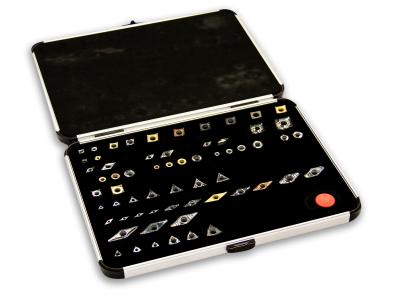
Arno Werkzeuge USA has expanded its range of high-positive, high-shear indexable inserts, which are ideally suited to cutting nonferrous and high-temperature alloys in turning applications. Engineered and manufactured in Germany by Arno Werkzeuge, this indexable insert range is one of the company's most popular product offerings, as it reportedly represents one of the widest ranges of indexable inserts available on the market today.
The Arno USA family of indexable inserts come in two broad ranges of edge conditions that cover the needs of almost any turning and cutting tools application. Arno USA’s ISO/ANSI indexable inserts for turning are available as standard carbide inserts with specially developed geometries and coatings. The Arno ISO/ANSI range features coated and uncoated carbide, with high-positive geometry, ultrahard cutting materials (PCBN and PCD). In North America, the ISO/ANSI series from Arno is popular and known for its versatility, efficiency and tool life when turning a variety of materials.
Within their newly expanded range of indexable inserts suitable for use machining high-nickel, high-cobalt and titanium-based alloys, Arno offer special geometries for chip fragmentation with polished surfaces, and specific edge hones for the optimal chip flow and metal-removal rates for enhanced cutting action and process reliability.
Martin Gardner, president, Arno Werkzeuge USA, added: “Our family of high-shear, high-positive inserts are one of the broadest ranges available. We offer many styles of inserts shapes from “C” to “W”, and they come in a wide variety of grades and chipbreakers. Some of the most popular styles from Arno’s new expanded range is our ALU, ASF and ACB geometries. This family is ideal for nonferrous materials (aluminum, copper, bronze and even plastics). It offers excellent chip flow and features an extremely sharp cutting-edge for a precise clean cut.”
Contact Details
Related Glossary Terms
- alloys
alloys
Substances having metallic properties and being composed of two or more chemical elements of which at least one is a metal.
- indexable insert
indexable insert
Replaceable tool that clamps into a tool body, drill, mill or other cutter body designed to accommodate inserts. Most inserts are made of cemented carbide. Often they are coated with a hard material. Other insert materials are ceramic, cermet, polycrystalline cubic boron nitride and polycrystalline diamond. The insert is used until dull, then indexed, or turned, to expose a fresh cutting edge. When the entire insert is dull, it is usually discarded. Some inserts can be resharpened.
- turning
turning
Workpiece is held in a chuck, mounted on a face plate or secured between centers and rotated while a cutting tool, normally a single-point tool, is fed into it along its periphery or across its end or face. Takes the form of straight turning (cutting along the periphery of the workpiece); taper turning (creating a taper); step turning (turning different-size diameters on the same work); chamfering (beveling an edge or shoulder); facing (cutting on an end); turning threads (usually external but can be internal); roughing (high-volume metal removal); and finishing (final light cuts). Performed on lathes, turning centers, chucking machines, automatic screw machines and similar machines.
